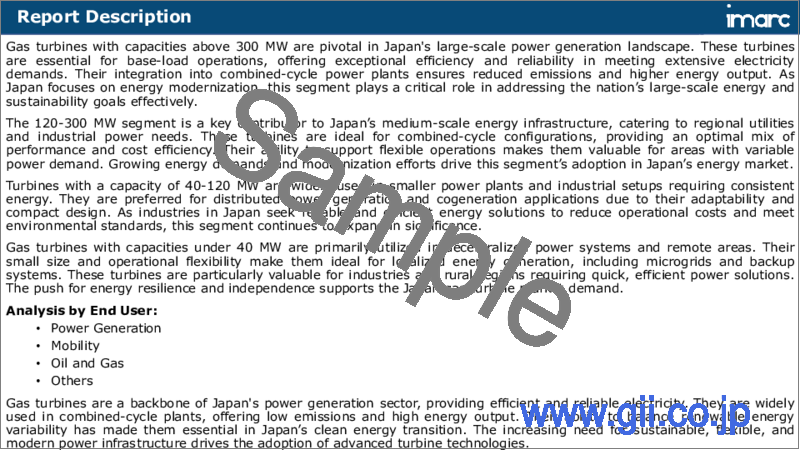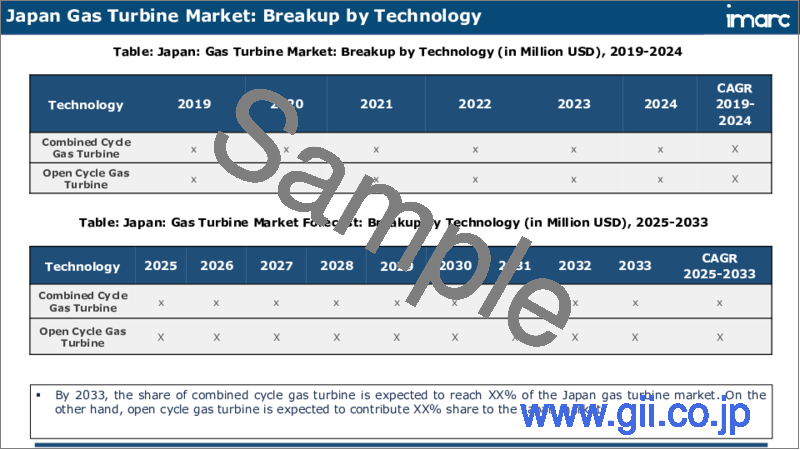|
|
市場調査レポート
商品コード
1609791
日本のガスタービン市場レポート:技術、設計タイプ、定格容量、エンドユーザー、地域別、2025年~2033年Japan Gas Turbine Market Report by Technology, Design Type (Heavy Duty Type, Aeroderivative Type), Rated Capacity, End User, and Region 2025-2033 |
||||||
カスタマイズ可能
|
|||||||
| 日本のガスタービン市場レポート:技術、設計タイプ、定格容量、エンドユーザー、地域別、2025年~2033年 |
|
出版日: 2024年12月05日
発行: IMARC
ページ情報: 英文 121 Pages
納期: 5~7営業日
|
全表示
- 概要
- 目次
日本のガスタービン市場の市場規模は2024年に16億米ドルに達しました。IMARC Groupは、2025年から2033年にかけての成長率(CAGR)は5.2%で、2033年には26億米ドルに達すると予測しています。分散型エネルギー資源やマイクログリッドなど、分散型発電の傾向が強まっており、小型で柔軟性の高いガスタービンの需要が高まっていることが、主に市場を牽引しています。
本レポートで扱う主な質問
- 日本のガスタービン市場はこれまでどのように推移し、今後どのように推移するのか?
- COVID-19の日本のガスタービン市場への影響は?
- 日本のガスタービン市場のテクノロジー別の内訳は?
- 日本のガスタービン市場の設計タイプ別の内訳は?
- 日本のガスタービン市場の定格容量別の内訳を教えてください。
- 日本のガスタービン市場のエンドユーザー別の内訳は?
- 日本のガスタービン市場のバリューチェーンにはどのような段階がありますか?
- 日本のガスタービンの主な促進要因と課題は?
- 日本のガスタービン市場の構造と主要プレーヤーは?
- 日本のガスタービン市場における競合の程度は?
目次
第1章 序文
第2章 調査範囲と調査手法
- 調査の目的
- ステークホルダー
- データソース
- 市場推定
- 調査手法
第3章 エグゼクティブサマリー
第4章 日本のガスタービン市場-イントロダクション
- 概要
- 市場力学
- 業界動向
- 競合情報
第5章 日本のガスタービン市場情勢
- 過去および現在の市場動向(2019年~2024年)
- 市場予測(2025年~2033年)
第6章 日本のガスタービン市場- 技術別内訳
- 複合サイクルガスタービン
- オープンサイクルガスタービン
第7章 日本のガスタービン市場- 設計タイプ別の内訳
- ヘビーデューティー(フレーム)タイプ
- 航空機転用型
第8章 日本のガスタービン市場- 定格容量別の内訳
- 300MW以上
- 120~300MW
- 40~120MW
- 40MW未満
第9章 日本のガスタービン市場- エンドユーザー別の内訳
- 発電
- モビリティ
- 石油・ガス
- その他
第10章 日本のガスタービン市場-競合情勢
- 概要
- 市場構造
- 市場プレーヤーのポジショニング
- 主要成功戦略
- 競合ダッシュボード
- 企業評価象限
第11章 主要企業のプロファイル
第12章 日本のガスタービン市場- 業界分析
- 促進要因・抑制要因・機会
- ポーターのファイブフォース分析
- バリューチェーン分析
第13章 付録
Japan gas turbine market size reached USD 1.6 Billion in 2024. Looking forward, IMARC Group expects the market to reach USD 2.6 Billion by 2033, exhibiting a growth rate (CAGR) of 5.2% during 2025-2033. The increasing trend toward decentralized power generation, including distributed energy resources and microgrids, which has enhanced the demand for smaller, more flexible gas turbines, is primarily driving the market.
A gas turbine, also known as a combustion turbine, is a type of internal combustion engine that converts chemical energy from fuel into mechanical energy through the process of combustion. It operates on the principle of the Brayton cycle, which consists of four key stages: air intake, compression, combustion, and exhaust. In a gas turbine, ambient air is drawn into the engine and compressed, increasing its pressure and temperature. This high-pressure air is then mixed with fuel and ignited, creating a high-velocity stream of hot gases. These gases expand through a series of turbines, which are connected to a shaft that drives various mechanical devices, such as aircraft propellers, electricity generators, or industrial machinery. As the gas flows through the turbines, it loses energy, generating useful mechanical work. Gas turbines are renowned for their efficiency, power-to-weight ratio, and versatility. They are widely used in aviation for propulsion, electricity generation in power plants, and even as mechanical drivers in various industrial applications, owing to their ability to deliver high power output with relatively low emissions.
Japan Gas Turbine Market Trends:
The gas turbine market in Japan is experiencing robust growth due to several key drivers. Firstly, the increasing regional demand for electricity continues to be a major catalyst. As populations grow and industries expand, the need for reliable and efficient power generation becomes paramount. Additionally, the shift towards cleaner energy sources has propelled the gas turbine market forward. Governments and organizations in Japan are prioritizing cleaner energy solutions to combat environmental challenges, making gas turbines an attractive choice for their lower emissions and fuel efficiency. Furthermore, the aerospace industry's growth has significantly contributed to the gas turbine market's expansion. The demand for more fuel-efficient and environmentally friendly aircraft engines has spurred innovation in gas turbine technology. Moreover, the rise of distributed power generation and the need for quick-start, grid-balancing solutions have boosted the market. Gas turbines' ability to rapidly respond to fluctuating power demands aligns with the evolving energy landscape. In conclusion, the gas turbine market's growth is expected to be driven by the rising demand for electricity, the push for cleaner energy sources, the aerospace industry's advancements, and the increasing need for flexible power generation solutions.
Japan Gas Turbine Market Segmentation:
Technology Insights:
- Combined Cycle Gas Turbine
- Open Cycle Gas Turbine
Design Type Insights:
- Heavy Duty (Frame) Type
- Aeroderivative Type
Rated Capacity Insights:
- Above 300 MW
- 120-300 MW
- 40-120 MW
- Less Than 40 MW
End User Insights:
- Power Generation
- Mobility
- Oil and Gas
- Others
Competitive Landscape:
The market research report has also provided a comprehensive analysis of the competitive landscape. Competitive analysis such as market structure, key player positioning, top winning strategies, competitive dashboard, and company evaluation quadrant has been covered in the report. Also, detailed profiles of all major companies have been provided.
Key Questions Answered in This Report:
- How has the Japan gas turbine market performed so far and how will it perform in the coming years?
- What has been the impact of COVID-19 on the Japan gas turbine market?
- What is the breakup of the Japan gas turbine market on the basis of technology?
- What is the breakup of the Japan gas turbine market on the basis of design type?
- What is the breakup of the Japan gas turbine market on the basis of rated capacity?
- What is the breakup of the Japan gas turbine market on the basis of end user?
- What are the various stages in the value chain of the Japan gas turbine market?
- What are the key driving factors and challenges in the Japan gas turbine?
- What is the structure of the Japan gas turbine market and who are the key players?
- What is the degree of competition in the Japan gas turbine market?
Table of Contents
1 Preface
2 Scope and Methodology
- 2.1 Objectives of the Study
- 2.2 Stakeholders
- 2.3 Data Sources
- 2.3.1 Primary Sources
- 2.3.2 Secondary Sources
- 2.4 Market Estimation
- 2.4.1 Bottom-Up Approach
- 2.4.2 Top-Down Approach
- 2.5 Forecasting Methodology
3 Executive Summary
4 Japan Gas Turbine Market - Introduction
- 4.1 Overview
- 4.2 Market Dynamics
- 4.3 Industry Trends
- 4.4 Competitive Intelligence
5 Japan Gas Turbine Market Landscape
- 5.1 Historical and Current Market Trends (2019-2024)
- 5.2 Market Forecast (2025-2033)
6 Japan Gas Turbine Market - Breakup by Technology
- 6.1 Combined Cycle Gas Turbine
- 6.1.1 Overview
- 6.1.2 Historical and Current Market Trends (2019-2024)
- 6.1.3 Market Forecast (2025-2033)
- 6.2 Open Cycle Gas Turbine
- 6.2.1 Overview
- 6.2.2 Historical and Current Market Trends (2019-2024)
- 6.2.3 Market Forecast (2025-2033)
7 Japan Gas Turbine Market - Breakup by Design Type
- 7.1 Heavy Duty (Frame) Type
- 7.1.1 Overview
- 7.1.2 Historical and Current Market Trends (2019-2024)
- 7.1.3 Market Forecast (2025-2033)
- 7.2 Aeroderivative Type
- 7.2.1 Overview
- 7.2.2 Historical and Current Market Trends (2019-2024)
- 7.2.3 Market Forecast (2025-2033)
8 Japan Gas Turbine Market - Breakup by Rated Capacity
- 8.1 Above 300 MW
- 8.1.1 Overview
- 8.1.2 Historical and Current Market Trends (2019-2024)
- 8.1.3 Market Forecast (2025-2033)
- 8.2 120-300 MW
- 8.2.1 Overview
- 8.2.2 Historical and Current Market Trends (2019-2024)
- 8.2.3 Market Forecast (2025-2033)
- 8.3 40-120 MW
- 8.3.1 Overview
- 8.3.2 Historical and Current Market Trends (2019-2024)
- 8.3.3 Market Forecast (2025-2033)
- 8.4 Less Than 40 MW
- 8.4.1 Overview
- 8.4.2 Historical and Current Market Trends (2019-2024)
- 8.4.3 Market Forecast (2025-2033)
9 Japan Gas Turbine Market - Breakup by End User
- 9.1 Power Generation
- 9.1.1 Overview
- 9.1.2 Historical and Current Market Trends (2019-2024)
- 9.1.3 Market Forecast (2025-2033)
- 9.2 Mobility
- 9.2.1 Overview
- 9.2.2 Historical and Current Market Trends (2019-2024)
- 9.2.3 Market Forecast (2025-2033)
- 9.3 Oil and Gas
- 9.3.1 Overview
- 9.3.2 Historical and Current Market Trends (2019-2024)
- 9.3.3 Market Forecast (2025-2033)
- 9.4 Others
- 9.4.1 Historical and Current Market Trends (2019-2024)
- 9.4.2 Market Forecast (2025-2033)
10 Japan Gas Turbine Market - Competitive Landscape
- 10.1 Overview
- 10.2 Market Structure
- 10.3 Market Player Positioning
- 10.4 Top Winning Strategies
- 10.5 Competitive Dashboard
- 10.6 Company Evaluation Quadrant
11 Profiles of Key Players
- 11.1 Company A
- 11.1.1 Business Overview
- 11.1.2 Product Portfolio
- 11.1.3 Business Strategies
- 11.1.4 SWOT Analysis
- 11.1.5 Major News and Events
- 11.2 Company B
- 11.2.1 Business Overview
- 11.2.2 Product Portfolio
- 11.2.3 Business Strategies
- 11.2.4 SWOT Analysis
- 11.2.5 Major News and Events
- 11.3 Company C
- 11.3.1 Business Overview
- 11.3.2 Product Portfolio
- 11.3.3 Business Strategies
- 11.3.4 SWOT Analysis
- 11.3.5 Major News and Events
- 11.4 Company D
- 11.4.1 Business Overview
- 11.4.2 Product Portfolio
- 11.4.3 Business Strategies
- 11.4.4 SWOT Analysis
- 11.4.5 Major News and Events
- 11.5 Company E
- 11.5.1 Business Overview
- 11.5.2 Product Portfolio
- 11.5.3 Business Strategies
- 11.5.4 SWOT Analysis
- 11.5.5 Major News and Events
12 Japan Gas Turbine Market - Industry Analysis
- 12.1 Drivers, Restraints, and Opportunities
- 12.1.1 Overview
- 12.1.2 Drivers
- 12.1.3 Restraints
- 12.1.4 Opportunities
- 12.2 Porters Five Forces Analysis
- 12.2.1 Overview
- 12.2.2 Bargaining Power of Buyers
- 12.2.3 Bargaining Power of Suppliers
- 12.2.4 Degree of Competition
- 12.2.5 Threat of New Entrants
- 12.2.6 Threat of Substitutes
- 12.3 Value Chain Analysis






